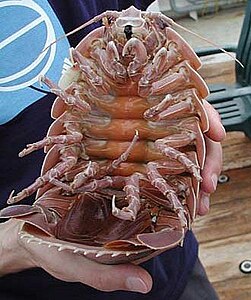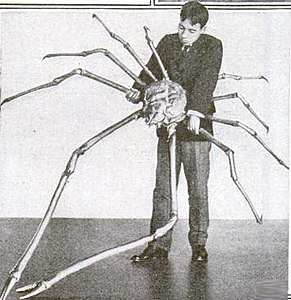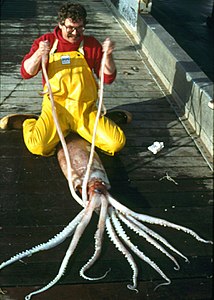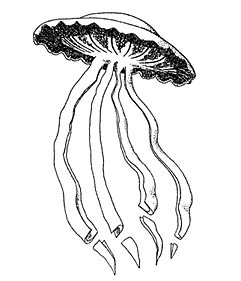Utente:Etrusko25/Sandbox 5

In zoologia il gigantismo abissale è la tendenza, diffusa in vari gruppi tassonomici, degli animali che vivono nelle parti più profonde degli oceani di raggiungere dimensioni maggiori di specie affini viventi a profondità minori. Le spiegazioni proposte per questo tipo di gigantismo includono il necessario adattamento a temperature più fredde, la scarsità di cibo, la ridotta pressione di predazione e l'aumento delle concentrazioni di ossigeno disciolto nelle profondità marine. Le difficili condizioni e l'inospitalità dell'ambiente sottomarino in generale, così come l'inaccessibilità della zona abissale per la maggior parte dei veicoli subacquei costruiti dall'uomo, hanno ostacolato lo studio di questo argomento.
Taxonomic range
[modifica | modifica wikitesto]Nei crostacei marini la tendenza all'aumento delle dimensioni con la profondità è stata osservata in misidacei, eufausiacei, decapodi, isopodi e anfipodi[1][2]. Non-arthropods in which deep-sea gigantism has been observed are cephalopods, cnidarians, and eels from the order Anguilliformes.[3]
Notable organisms that exhibit deep-sea gigantism include the big red jellyfish,[4] Stygiomedusa jellyfish, the giant isopod,[5] giant ostracod,[5] the giant sea spider,[5] the giant amphipod, the Japanese spider crab, the giant oarfish, the deepwater stingray, the seven-arm octopus,[6] and a number of squid species: the colossal squid (up to 14 m in length),[7] the giant squid (up to 12 m),[7] Megalocranchia fisheri, robust clubhook squid, Dana octopus squid, cockatoo squid, giant warty squid, and the bigfin squids of the genus Magnapinna.
Deep-sea gigantism is not generally observed in the meiofauna (organisms that pass through a 1 mm mesh), which actually exhibit the reverse trend of decreasing size with depth.[8]
Explanations
[modifica | modifica wikitesto]Lower temperature
[modifica | modifica wikitesto]In crustaceans, it has been proposed that the explanation for the increase in size with depth is similar to that for the increase in size with latitude (Bergmann's rule): both trends involve increasing size with decreasing temperature.[1] The trend with latitude has been observed in some of the same groups, both in comparisons of related species, as well as within widely distributed species.[1] Decreasing temperature is thought to result in increased cell size and increased life span (the latter also being associated with delayed sexual maturity[8]), both of which lead to an increase in maximum body size (continued growth throughout life is characteristic of crustaceans).[1] In Arctic and Antarctic seas where there is a reduced vertical temperature gradient, there is also a reduced trend towards increased body size with depth, arguing against hydrostatic pressure being an important parameter.[1]
Temperature does not appear to have a similar role in influencing the size of giant tube worms. Riftia pachyptila, which lives in hydrothermal vent communities at ambient temperatures of 2–30 °C,[9] reaches lengths of 2.7 m, comparable to those of Lamellibrachia luymesi, which lives in cold seeps. The former, however, has rapid growth rates and short life spans of about 2 years,[10] while the latter is slow growing and may live over 250 years.[11]
Food scarcity
[modifica | modifica wikitesto]Food scarcity at depths greater than 400 m is also thought to be a factor, since larger body size can improve ability to forage for widely scattered resources.[8] In organisms with planktonic eggs or larvae, another possible advantage is that larger offspring, with greater initial stored food reserves, can drift for greater distances.[8] As an example of adaptations to this situation, giant isopods gorge on food when available, distending their bodies to the point of compromising ability to locomote;[12] they can also survive 5 years without food in captivity.[13][14]
According to Kleiber's law,[15] the larger an animal gets, the more efficient its metabolism becomes; i.e., an animal's basal metabolic rate scales to roughly the ¾ power of its mass. Under conditions of limited food supply, this may provide additional benefit to large size.
Reduced predation pressure
[modifica | modifica wikitesto]An additional possible influence is reduced predation pressure in deeper waters.[16] A study of brachiopods found that predation was nearly an order of magnitude less frequent at the greatest depths than in shallow waters.[16]
Increased dissolved oxygen
[modifica | modifica wikitesto]Dissolved oxygen levels are also thought to play a role in deep-sea gigantism. A 1999 study of benthic amphipod crustaceans found that maximum potential organism size directly correlates with increased dissolved oxygen levels of deeper waters.[17] The solubility of dissolved oxygen in the oceans is known to increase with depth because of increasing pressure, decreasing salinity levels and temperature.[17]
The proposed theory behind this trend is that deep-sea gigantism could be an adaptive trait to combat asphyxiation in ocean waters.[18] Larger organisms are able to intake more dissolved oxygen within the ocean, allowing for sufficient respiration. However, this increased absorption of oxygen runs the risk of toxicity poisoning where an organism can have oxygen levels that are so high that they become harmful and poisonous.[18]
Gallery
[modifica | modifica wikitesto]-
A giant isopod (Bathynomus giganteus) may reach up to 0,76 m (2 ft 6 in) in length.
-
A Japanese spider crab whose outstretched legs measured 3,7 m (12 ft) across.
-
A robust clubhook squid, whose mantle reaches 2 m (6 ft 7 in) in length, caught off Alaska.
-
A 7 m (23 ft) king of herrings oarfish, washed up on the beach of a Navy SEAL training base in California.
-
A Colossendeis colossea sea spider, displayed at the Smithsonian.
-
A Stygiomedusa jellyfish, which can grow up to Template:Cvt in length.
-
A deepwater stingray, which can reach up to 2,7 m × 1,5 m (8 ft 10 in × 4 ft 11 in) in size.
See also
[modifica | modifica wikitesto]References
[modifica | modifica wikitesto]- ^ a b c d e S. F. Timofeev, Bergmann's Principle and Deep-Water Gigantism in Marine Crustaceans, in Biology Bulletin of the Russian Academy of Sciences, vol. 28, n. 6, 2001, pp. 646–650, DOI:10.1023/A:1012336823275.
- ^ McClain C. e Rex M., The relationship between dissolved oxygen concentration and maximum size in deep-sea turrid gastropods: an application of quantile regression, in Marine Biology, vol. 139, n. 4, 2001-10-01, Bibcode:2001MarBi.139..681C, DOI:10.1007/s002270100617, ISSN 0025-3162.
- ^ Hanks, Micah, Deep Sea Gigantism: Curious Cases of Mystery Giant Eels, su mysteriousuniverse.org.
- ^ Smithsonian Oceans, Big Red Jellyfish, su ocean.si.edu.
- ^ a b c Errore nelle note: Errore nell'uso del marcatore
<ref>: non è stato indicato alcun testo per il marcatoreDeepSeaNews - ^ The giant deep-sea octopus Haliphron atlanticus forages on gelatinous fauna, in Scientific Reports, vol. 7, 27 marzo 2017, p. 44952, DOI:10.1038/srep44952.
- ^ a b Anderton, Jim, Amazing specimen of world's largest squid in NZ, su beehive.govt.nz, New Zealand Government, 22 February 2007.
- ^ a b c d Giant Higgins-larvae with paedogenetic reproduction from the deep sea of the Angola Basin? Evidence for a new life cycle and for abyssal gigantism in Loricifera?, in Organisms Diversity & Evolution, vol. 5, 2005, pp. 59–75, DOI:10.1016/j.ode.2004.10.005.
- ^ M. Bright, The biology of vestimentiferan tubeworms (PDF), Taylor & Francis, 2010, pp. 213–266, DOI:10.1201/ebk1439821169, ISBN 978-1-4398-2116-9.
- ^ Rapid growth at deep-sea vents, in Nature, vol. 371, n. 6499, 1994, p. 663, DOI:10.1038/371663a0.
- ^ Ian R. MacDonald, Stability and Change in Gulf of Mexico Chemosynthetic Communities (PDF), su data.boem.gov, MMS, 2002.
- ^ Aspects of the biology of the giant isopod Bathynomus giganteus A. Milne Edwards, 1879 (Flabellifera: Cirolanidae), off the Yucatan Peninsula, in Journal of Crustacean Biology, vol. 11, n. 3, 1991, pp. 375–385, DOI:10.2307/1548464.
- ^ Jack Gallagher, Aquarium's deep-sea isopod hasn't eaten for over four years, su japantimes.co.jp, The Japan Times, 26 febbraio 2013.
- ^ I Won't Eat, You Can't Make Me! (And They Couldn't), su npr.org, NPR, February 22, 2014.
- ^ Body Size and Metabolic Rate, in Physiological Reviews, vol. 27, n. 4, 1947, pp. 511–541, DOI:10.1152/physrev.1947.27.4.511.
- ^ a b Latitudinal and depth gradients in marine predation pressure, in Global Ecology and Biogeography, vol. 25, n. 6, 2016, pp. 670–678, DOI:10.1111/geb.12444.
- ^ a b (EN) Polar gigantism dictated by oxygen availability, in Nature, vol. 399, n. 6732, 1999, pp. 114–115, DOI:10.1038/20099.
- ^ a b Why polar gigantism and Palaeozoic gigantism are not equivalent: effects of oxygen and temperature on the body size of ectotherms, in Functional Ecology, vol. 27, n. 6, 2013, pp. 1275–1285, DOI:10.1111/1365-2435.12152.















